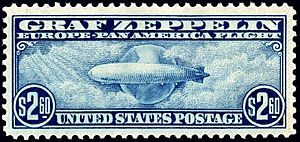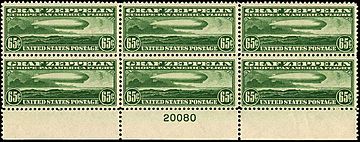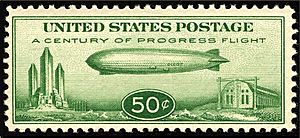1930 Graf Zeppelin stamps facts for kids
The 1930 Graf Zeppelin stamps were a special set of three airmail postage stamps. Each stamp showed a picture of the famous Graf Zeppelin airship. The United States Post Office Department released them in 1930. They were only for mail sent on that specific airship.
These stamps were valid for mail on the Zeppelin's Pan American flight. This flight went from Germany to the United States, stopping in Brazil. However, the stamps were mostly sold to collectors. They also helped promote the new airship route. Most of the money from these stamps (93.5%) went to the Zeppelin Airship Works in Germany. The stamps were a friendly gesture towards Germany.
The stamps were used for a short time and then taken off sale. The Post Office Department destroyed all the unsold stamps. These stamps were very expensive during the Great Depression. Because of this, most people and collectors could not afford them. Only about 227,000 stamps were sold, which was just 7% of all the stamps printed. This makes them quite rare and valuable to collectors today.
Contents
How Were the Zeppelin Stamps Created?
The Graf Zeppelin airship first flew in 1928. It quickly set new records for long-distance flights. To celebrate its success, the Zeppelin Company planned a flight to Rio de Janeiro.
The United States Post Office agreed to create these stamps. This was a friendly act towards Germany. The stamps honored the Graf Zeppelin and its upcoming transatlantic flight. People used them to pay for mail carried on the airship. The Graf Zeppelin was a huge rigid airship, over 775 feet (236 m) long. It would carry mail from Germany to North and South America and back.
All three stamps showed the Graf Zeppelin in different ways. They were first released in Washington, D.C., on April 19, 1930. This was one month before the historic first flight. Other post offices started selling them on April 21, 1930.
The Graf Zeppelin left Friedrichshafen, Germany, on May 30, 1930. It returned on June 6. The 65-cent and $1.30 stamps paid for postcards and letters. These were carried on the last part of the journey from the U.S. to Seville, Spain and Friedrichshafen. The $1.30 and $2.60 stamps paid for round-trip postcards and letters. These went via Friedrichshafen or Seville. A round-trip letter cost $3.90. This was the exact cost of a $2.60 and a $1.30 stamp together.
Mail with Zeppelin stamps was sent to Germany by boat. It was then picked up in Friedrichshafen. From there, it went aboard the Graf Zeppelin. The week-long flight went from Germany to Brazil, then to the United States. Finally, it returned to Friedrichshafen.
The Bureau of Engraving and Printing made the stamps. They had only six weeks to design, print, and send them out. The stamps needed to be ready for the flight to Germany. The U.S. Post Office made only a small profit (6.5%) from stamps actually used on the airship. The German Zeppelin Airship Works got most of the money for those stamps. The U.S. Post Office expected that most stamps would be sold to collectors. They would keep all the money from those sales.
The Bureau of Engraving and Printing made plates for 200 stamps. These were divided into four sheets of 50 stamps each. The sheets had 11 gauge perforations. Each sheet had a paper margin around all four sides. This means no stamp has a straight edge.
They printed 1,000,000 of each stamp value. But only 227,260 stamps were sold in total. This is just 7% of the total printed. The Zeppelin stamps were taken off sale on June 30, 1930. The Post Office Department destroyed all the remaining stamps.
All three stamps had a similar border design. The top border said GRAF ZEPPELIN and EUROPE – PAN AMERICAN FLIGHT. The bottom border said UNITED STATES POSTAGE. Each stamp was printed in a different color. These attractive stamps were highly advertised. But some collectors were upset. They thought the Post Office charged too much. They also felt the Post Office tried to make the stamps more valuable by destroying unsold ones. The total cost for the set of three stamps was $4.55. This was a lot of money during the depression years. However, over time, these stamps became very popular. They are now highly wanted by stamp and postal history collectors.
The 65-Cent Graf Zeppelin Stamp
The 65-cent stamp is green. It shows the Graf Zeppelin flying east over the Atlantic Ocean. Like the others, it says GRAF ZEPPELIN - EUROPE PAN AMERICAN FLIGHT at the top. It says UNITED STATES POSTAGE at the bottom. This was the lowest value stamp. It paid for postcards. The Scott catalog number for this stamp is C13. Out of 1,000,000 printed, 93,336 were sold.
The $1.30 Graf Zeppelin Stamp
The $1.30 stamp was also first released in Washington, D.C., on April 19, 1930. It is brown. This stamp shows the Graf Zeppelin flying west. It is placed over a map of Europe, South America, and North America. The map shows names of different cities. This stamp paid for postcards and letters on the May 1930 Pan American flight. That flight went from Germany to Brazil and then to the United States. Postage costs changed based on the distance. The Scott catalog number for this stamp is C14. Out of 1,000,000 printed, only 72,428 were sold.
The $2.60 Graf Zeppelin Stamp
The $2.60 stamp is blue. It shows the Graf Zeppelin flying through clouds. It is placed over a globe and heading west. C. A. Huston and A. R. Meissner designed this stamp. The Scott catalog number for this stamp is C15. Out of 1,000,000 printed, only 61,296 were sold.
Mail Carried by the Zeppelin
Mail carried by the Graf Zeppelin airship got special cancellations and cachets. A cancellation is a mark on a stamp to show it's been used. A cachet is a design or message added to an envelope. The cover shown here made the full round trip. It has all three Zeppelin stamps on a 5-cent Air Post envelope. It also has special hand-stamped cachets. The diamond-shaped cachet shows a map of the Graf Zeppelin's first flight route. There is also a red cancellation mark. This mark was specially made to cancel mail carried by the Zeppelin. It has the name of Friedrichshafen and a picture of the Zeppelin.
Other Types of Zeppelin Stamps
A Different Zeppelin Stamp
A 50-cent Zeppelin stamp was released on October 2, 1933. Collectors often call it the "Baby Zeppelin." It was made for the Century of Progress exhibition. 324,700 of these were issued. This stamp should not be confused with the 1930 Zeppelin stamps. Since many more of these were made, they are much less expensive than the 1930 stamps.










